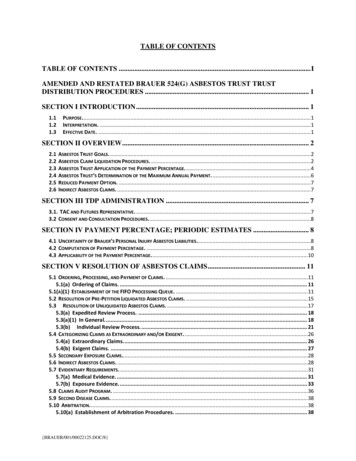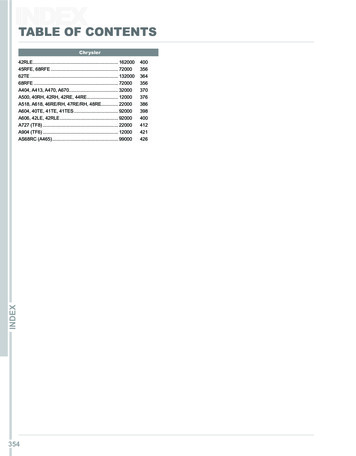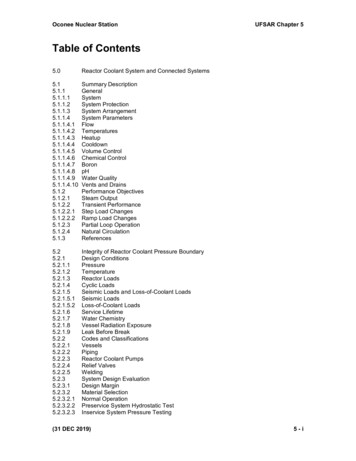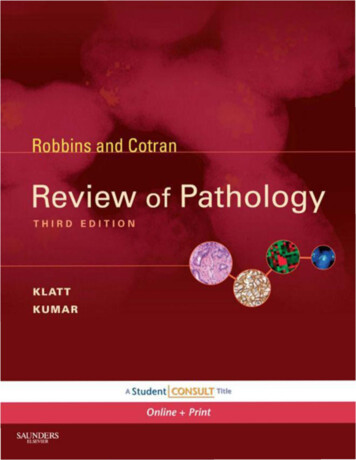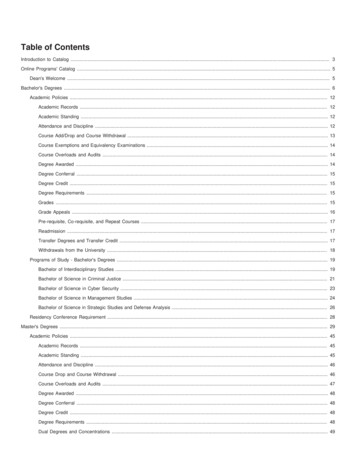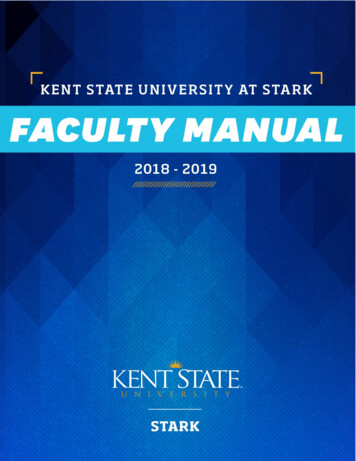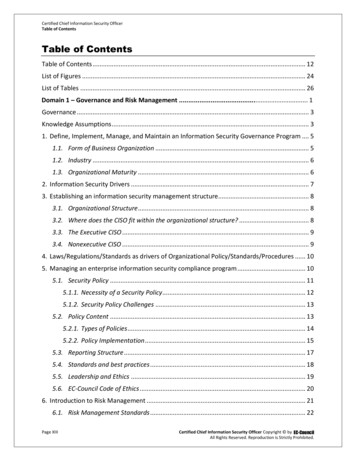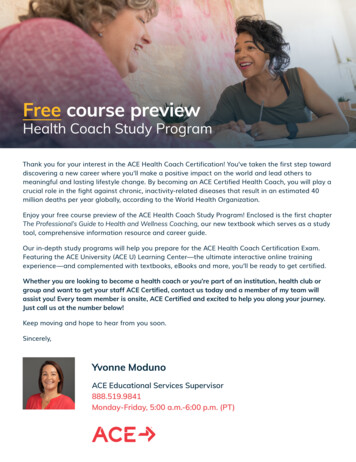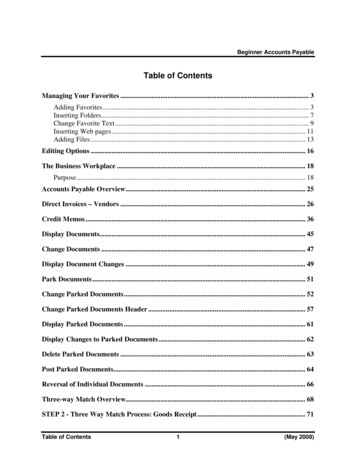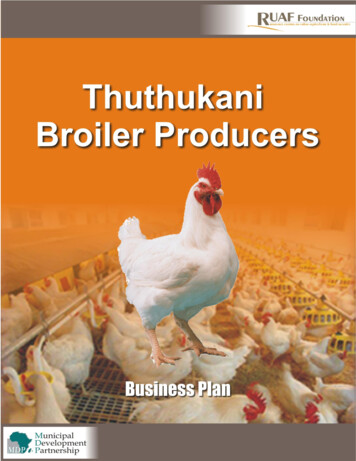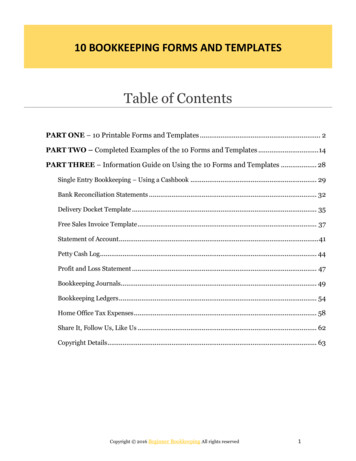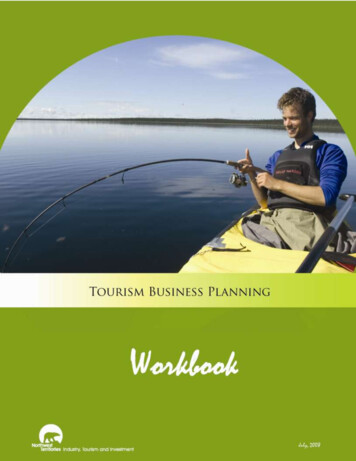
Transcription
Table of ContentsIn tro du ctio n . 4Tourism in the NWT.5The elements of a tourism business plan .6Business Plan Worksheets .7Step One – Overview of Your Business Experience (Worksheets 1, 2) .7Worksheet #1 - General Information, Qualifications, Experience .8Worksheet #2 - Self Assessment . 13Step Two – Your Business Idea (Worksheets 3-6) . 16What will your business look like? . 16Tourism and Parks Division . 16NWT Tourism . 16Publications that may help you complete this step include: . 17Other information sources: . 17Worksheet #3 - Describe Your Business Idea . 18Worksheet #4 - Who will buy Your Product? . 22Worksheet #5 - Selling Features of Your Product . 26Worksheet #6 – Level of Risk and Market Acceptance. 28Step Three – Your Business Environment (Worksheets 7-9). 29What do you know about the environment you will operate in? . 29Legal and regulatory requirements . 29Worksheet #7 - Legal and Licensing Requirements . 31Worksheet #8 - Your Business Environment. 34Worksheet #9 - Competition . 37Step Four – Developing and Marketing Your Product (Worksheets 10-13) . 39How will you develop and market your product or service? . 39Site development (Worksheets 10, 11) . 39Packaging your tourism product (Worksheet 12) . 40Marketing your Product (Worksheet 13) . 44Worksheet #10 - Site Evaluation . 45Worksheet #10 - Site Evaluation . 45Tourism Business Planning A WorkbookPage 2
Worksheet #11 - Building and Land Development Requirements . 48Worksheet #12 - Packaging the Product . 53Worksheet #13 – How will you Market your Product? . 56Step Five - Risk Management (Worksheet 14) . 58Worksheet #14 - Risk Management. 59Step Six – Financial Planning (Worksheets 15-18) . 60What are your financial plans? . 60Steps in financial analysis . 60Projected income statements. 60Projected cash flow and working capital needed . 62Financing methods . 62Worksheet #15 - Estimate your Capital and Start up Costs . 63Worksheet #16 - Forecast your Income . 76Worksheet #17 - Projected Balance Sheet . 79Worksheet #18 - Potential Sources of Financing . 81Step Seven – Will Your Business Be Successful? (Worksheets 19-20) . 85How do you know you can succeed? . 85Evaluate rate of return and feasibility . 85Worksheet #19 - Evaluate Financial Feasibility . 87Worksheet #20 - Supporting Documents . 89Appendix: GNWT Industry, Tourism and Investment - Guide to Proposal Submissions: Tourism ProductDiversification and Marketing Program . 92Schedule 1: Business Planning and Transition Assistance . 92Tourism Business Planning A WorkbookPage 3
IntroductionThis Workbook accompanies the Tourism Development Handbook (TDH) for theNorthwest Territories.1 The Workbook guides the reader through a step-by-stepprocess for developing a business plan for a tourism business.In the Workbook, information taken from the TDH is combined with a series ofworksheets to produce the information needed for writing a formal Business Plan.The worksheets may be completed independently or in a workshop or tutorial setting.Consultants are available who may use the filled in worksheets to prepare a formalBusiness Plan.1Business or economicdevelopment officersare available to guideyou. Contact yourregional office ofIndustry, Tourism andInvestment.Contacts andResources are listed inSection 16 of the TDH.Hereafter abbreviated as TDHTourism Business Planning A WorkbookPage 4
Preparing to PlanTourism in the NWTTourism is an important part of the NWT economy and generates more revenuetoday than all other renewable resource industries combined. The NWT receivesaround 60,000 non-resident visitors each year who contribute on average over 110 million to the territorial economy.A carefully developedBusiness Plan is anessential step in thecreation of asuccessful tourismbusiness in theNorthwest Territories.The Government of the NWT (GNWT), through the Department of Industry,Tourism and Investment (ITI), provides resources and support to the NWTtourism industry for tourism marketing, research, training, and product development. NWT Tourism (NWTT), onbehalf of the GNWT, delivers the marketing functions and is designated as the Destination Marketing Organization(DMO) for the NWT.2The tourism industry in the NWT is made up of a number of businesses including big game outfitters, fishingoperators, outdoor adventure providers, as well as related sectors including transportation, accommodation andfoodservices. Tourism is an experience composed of a variety of elements, any and all of which will contribute to theoverall satisfaction (or lack of satisfaction) of the traveler.There are many types of travelers, including vacation travelers, people visiting friends and family, and peopletraveling on business. Worldwide, and particularly across North America, leisure travel has been changed by thegrowth of affluent, well-educated adult travelers and the decline of middle-income family travelers. Extensive,quantitative research indicates that the Northwest Territories‟ current and highest potential „best‟ audiences are:The upscale North American ‘Boomer’ Audience: affluent, well educated Canadians and Americans, 40 – 60 yrs old, who regularlyspend 6 - 8k per person on travel, annually.Sector specific audiences for hunting, lodge fishers, Japanese Aurora and ‘outfitted’ outdoor adventure enthusiasts.German touring audience, (the Dempster Highway and the Deh Cho Travel Connection).These priority audiences prefer „off the beaten path‟ escapes from the stress of daily life for travel experiences that arerejuvenating and intellectually stimulating. They look for a sense of awe and wonder in natural environments.323See TDH p. 108 for a list of NWT Tourism responsibilitiesP.1 Guide to Proposal Submissions: Tourism Product Diversification and Marketing Program, ITI, 2007Tourism Business Planning A WorkbookPage 5
The elements of a tourism business planThe business plan is the basis of your submission to lenders and investors and will contain the summary of all yourfinancial research. The plan describes your business goals and the business concept in relation to local/regional andtourism markets. It outlines the way in which you intend to finance and manage your project. It incorporates adetailed financial analysis, including cash flow forecasts, projected income statements and pro-forma balance sheets.Your business plan will guide you, as well as others, as to what your business can be expected to achieve. It shouldcontain these elements:A summary of your proposal, the intended product/service and target marketgroup(s), a description of industry trends, your competitive positioning,management highlights and the financing request at hand.A description of the organizational form of the business that highlights theskills, experience and responsibilities of the owner and management team. Thissection should contain a discussion of the developer‟s background – who is involved,what other business ventures is he/she involved in and what is his/her track recordin business.A description of your business and its goals/objectives, including neededresources, anticipated sales volume, market share estimates, visitor satisfactiongoals, and repeat visitation and/or other similar targets relevant to a tourismbusiness.A marketing plan based on a description of the products (or services) that youwill market with a discussion of trends, competition, and identification of yourtarget markets and how you will market your product.We have very littleproduct and productpackages orientedtoward our prioritymarket audiences:those travelers seekingrejuvenatingexperiences. OurAurora viewing sector,which relies almostentirely on a Japanesemarket, is facing stiffcompetition fromAlaska.(Guide to ProposalSubmissions: TourismProduct Diversificationand MarketingProgram, ITI, 2007)A financial plan, that includes projected income statements, cash flow statements and pro-forma balance sheetsthat provide detailed monthly operating forecasts for the first year of operation and annual forecasts for the next twoto three years. (Includes opening balance sheet and statement of construction/start-up costs and sources offinancing.)A discussion of operations, including location, travel and supply log
The elements of a tourism business plan The business plan is the basis of your submission to lenders and investors and will contain the summary of all your financial research. The plan describes your business goals and the business concept in relation to local/regional and tourism markets. It outlines the way in which you intend to finance and manage your project. It incorporates a
